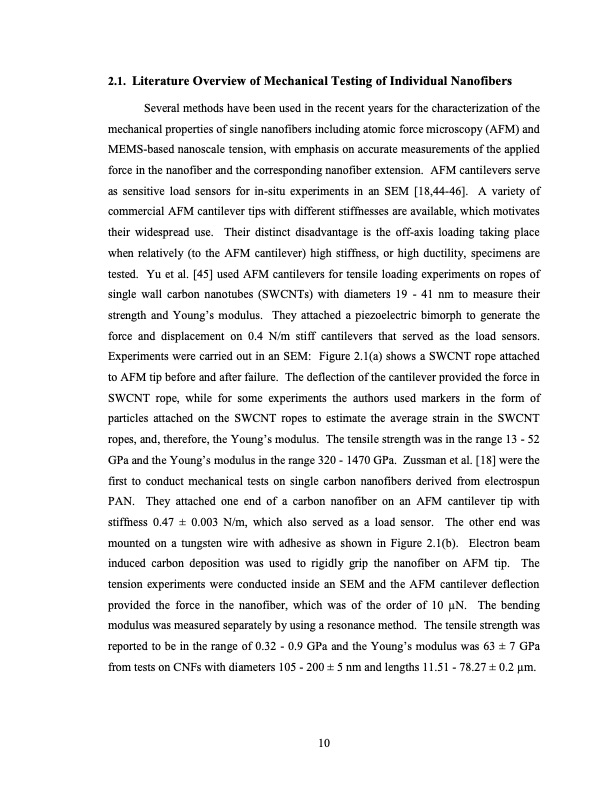
PDF Publication Title:
Text from PDF Page: 017
2.1. Literature Overview of Mechanical Testing of Individual Nanofibers Several methods have been used in the recent years for the characterization of the mechanical properties of single nanofibers including atomic force microscopy (AFM) and MEMS-based nanoscale tension, with emphasis on accurate measurements of the applied force in the nanofiber and the corresponding nanofiber extension. AFM cantilevers serve as sensitive load sensors for in-situ experiments in an SEM [18,44-46]. A variety of commercial AFM cantilever tips with different stiffnesses are available, which motivates their widespread use. Their distinct disadvantage is the off-axis loading taking place when relatively (to the AFM cantilever) high stiffness, or high ductility, specimens are tested. Yu et al. [45] used AFM cantilevers for tensile loading experiments on ropes of single wall carbon nanotubes (SWCNTs) with diameters 19 - 41 nm to measure their strength and Young’s modulus. They attached a piezoelectric bimorph to generate the force and displacement on 0.4 N/m stiff cantilevers that served as the load sensors. Experiments were carried out in an SEM: Figure 2.1(a) shows a SWCNT rope attached to AFM tip before and after failure. The deflection of the cantilever provided the force in SWCNT rope, while for some experiments the authors used markers in the form of particles attached on the SWCNT ropes to estimate the average strain in the SWCNT ropes, and, therefore, the Young’s modulus. The tensile strength was in the range 13 - 52 GPa and the Young’s modulus in the range 320 - 1470 GPa. Zussman et al. [18] were the first to conduct mechanical tests on single carbon nanofibers derived from electrospun PAN. They attached one end of a carbon nanofiber on an AFM cantilever tip with stiffness 0.47 ± 0.003 N/m, which also served as a load sensor. The other end was mounted on a tungsten wire with adhesive as shown in Figure 2.1(b). Electron beam induced carbon deposition was used to rigidly grip the nanofiber on AFM tip. The tension experiments were conducted inside an SEM and the AFM cantilever deflection provided the force in the nanofiber, which was of the order of 10 μN. The bending modulus was measured separately by using a resonance method. The tensile strength was reported to be in the range of 0.32 - 0.9 GPa and the Young’s modulus was 63 ± 7 GPa from tests on CNFs with diameters 105 - 200 ± 5 nm and lengths 11.51 - 78.27 ± 0.2 μm. 10PDF Image | HIGH STRENGTH CARBON NANOFIBERS DERIVED FROM ELECTROSPUN POLYACRYLONITRILE

PDF Search Title:
HIGH STRENGTH CARBON NANOFIBERS DERIVED FROM ELECTROSPUN POLYACRYLONITRILEOriginal File Name Searched:
4835609.pdfDIY PDF Search: Google It | Yahoo | Bing
Sulfur Deposition on Carbon Nanofibers using Supercritical CO2 Sulfur Deposition on Carbon Nanofibers using Supercritical CO2. Gamma sulfur also known as mother of pearl sulfur and nacreous sulfur... More Info
CO2 Organic Rankine Cycle Experimenter Platform The supercritical CO2 phase change system is both a heat pump and organic rankine cycle which can be used for those purposes and as a supercritical extractor for advanced subcritical and supercritical extraction technology. Uses include producing nanoparticles, precious metal CO2 extraction, lithium battery recycling, and other applications... More Info
| CONTACT TEL: 608-238-6001 Email: greg@infinityturbine.com | RSS | AMP |